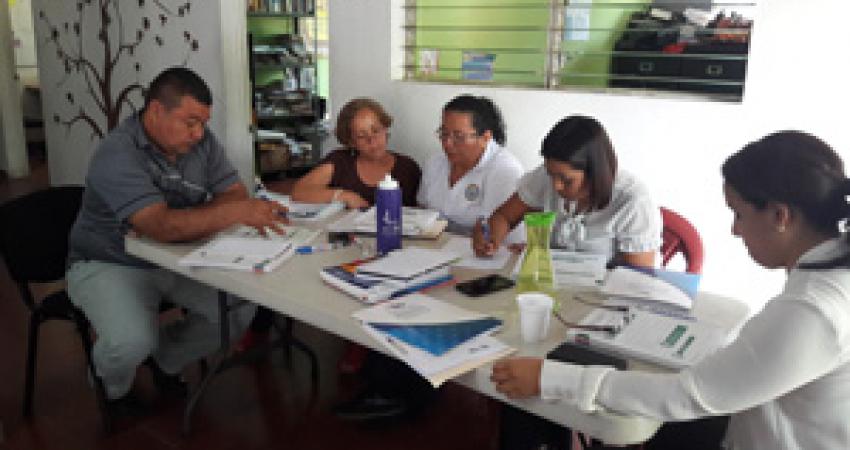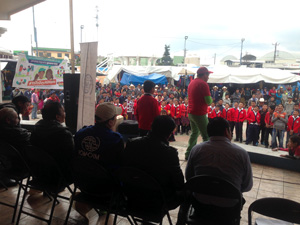Specialized Course on Migrant Children in Mesoamerica

The countries in the Mesoamerica region are replicating a specialized course regarding migrant children, resulting in officers who are continuously better equipped to face the challenged inherent in offering adequate attention to the thousands of girls, boys, and adolescents migrating in the region.

With the start of these courses in Honduras, El Salvador and Guatemala, six of the countries in the region are already working on strengthening their capacities to protect the human rights of migrant children, reaching almost 350 participants. Mexico, Costa Rica and Nicaragua have also initiated their respective training processes.
The specialized course on migrant children of the International Organization for Migration (IOM) was developed to attend the needs of this migrant population, to achieve a differentiated approach, and to secure the protection of the human rights of children and adolescents.
Unaccompanied migrant children and adolescents are at high-risk for becoming victims of extortion, sexual abuse, and human trafficking along the migration routes. According to official statistics, 34,000 girls, boys, and adolescents were returned to El Salvador, Honduras, and Guatemala in 2016 alone.

These national courses on migrant children involve 21 hours of independent study and 60 hours of in-class work, and are imparted in a continuous manner from April to June.
This is one of the actions supported by IOM through the Mesoamerica Project “Strengthening the Capacities for the Protection and Assistance of Migrants in Situations of Vulnerability’’, financed by the Office of Population, Refugees and Migration of the Department of State of the United States.
Guatemala
With the presence of more than 40 representatives from different governmental, non-governmental and civil society institutions, the specialized course on migrant children was imparted in the departments of San Marcos and Quetzaltenango.
The course methodology is meant to create a participative environment for the beneficiaries, this taking into account that the institution’s experiences are used as a reference in order to improve the competences of the officers. In addition, this participation factor helps creating direct communication channels between the actors that intervene in migratory processes; strengthening inter-institutional communication, so that upon action, the assistance offered to migrant children is integrated and dealt with by multi-disciplinary team representing institutions from both, the public and private sector.
El Salvador
The course that started in April in San Salvador, Santa Ana and San Miguel has involved a total of 79 officers from public institutions, including the National Civil Police, the National Commission for Children and Adolescents, the Salvadorian Institute for the Integrated Development of Children and Adolescents, The State General Attorney, The Attorney for the Defense of Human Rights, the Ministry of Health, the Municipality of Santa Ana, the Primary Jury on Minors of Santa Ana, and the Secretariat for Social Inclusion.
One of the most remarkable aspects of this activity is that in various countries, including El Salvador, who imparts some of the modules of the course are students who graduated from the specialized course the first time it was offered, as well as partners from organizations such as UNHCR and UNICEF.
Honduras
In the case of Honduras, the training on migrant children was offered in Tegucigalpa, and it also focused on helping the participants to recognize sustainable actions that will favour the integrated protection of migrant girls, boys and adolescents.
During ten weeks, and under a classroom modality, 50 participants will analyze topics such as migration trendsand contexts, factors of child migration and regional guidelines for comprehensive protection.
Jorge Peraza Breedy, IOM Chief of Mission for El Salvador, Guatemala and El Salvador mentioned: ‘”we seek to generate, in the students, good practices under the framework of Human Rights, gender, diversity, the best interest of the child andparticipation”.
Mexico
The course in Mexico took place over the course of 5 weeks in the city of Tuxtla Gutierrez, en the State of Chiapas, and counted with 27 participants.
The level of interest of the participants increased in each session, as the course progressed and their knowledge on the subject augmented.
Carmen Monzon, one of the participants, wrote in her final report about the importance of this activity: ‘”I consider important to prepare oneself and every officer, who in line with their duties, experience contact with minors, especially those who in a state of vulnerability such as boys, girls and adolescents, to think and act under the framework of human rights, and a knowledge of other international instruments on the subject”.